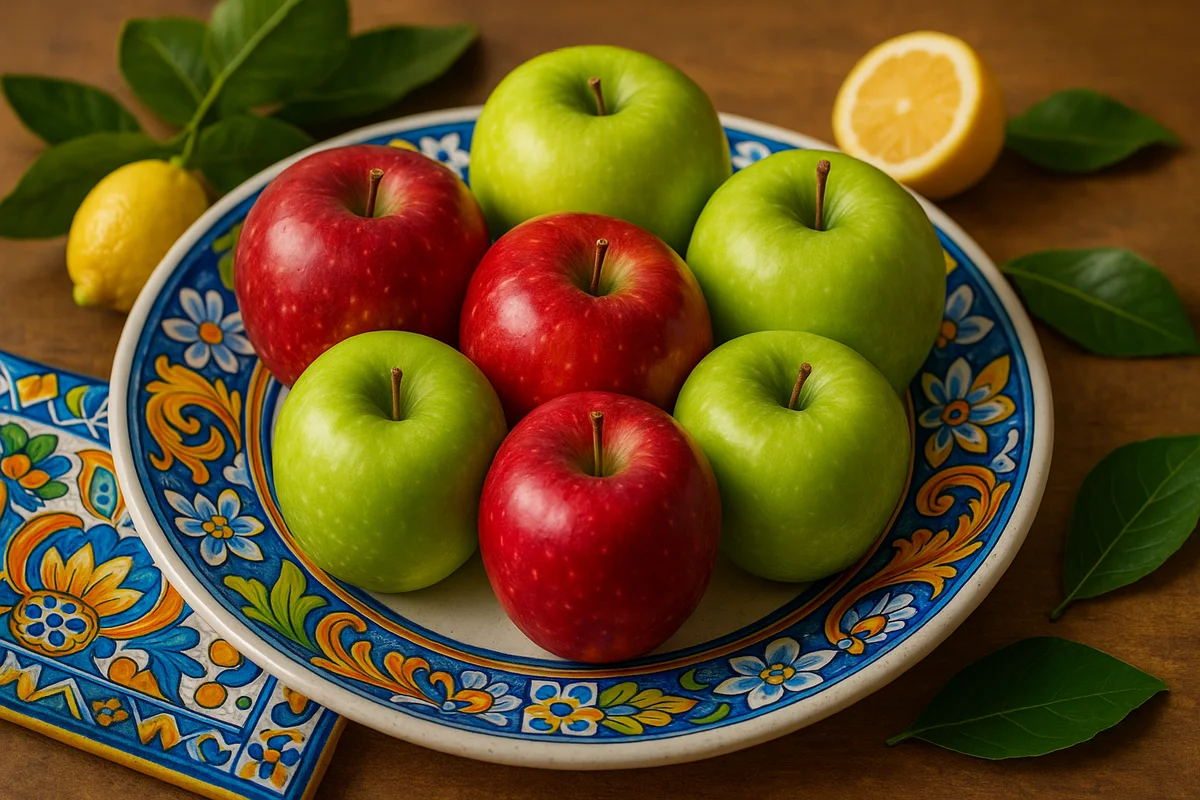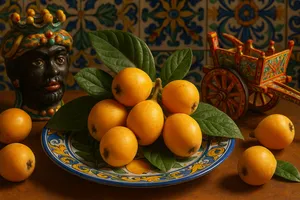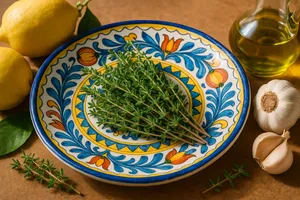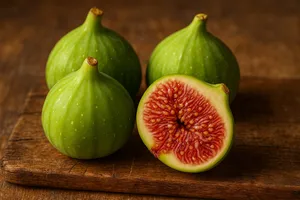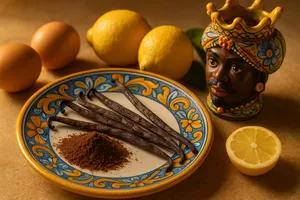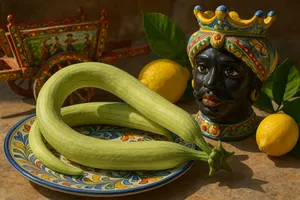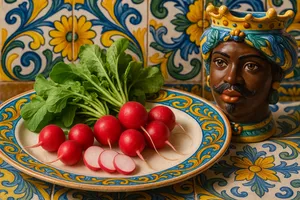Overview
Apple, called in Sicilian “pumu”, is the fruit of the apple tree (Malus domestica), cultivated since antiquity and widespread throughout the world. In Sicily, apple growing is concentrated in the inland mountain and hillside areas, especially in the Nebrodi, the Madonie and on Mount Etna, where the cooler climate and temperature variation favour the development of fruit of excellent quality. Although Sicily is not as renowned for apples as it is for citrus fruits, the local varieties grown in the mountain areas have distinctive characteristics and are greatly appreciated.
In Sicilian tradition, apple represented the quintessential autumn and winter fruit in the mountain regions. Its ability to keep for long periods made it precious: it was stored in cool, dry places, wrapped in paper, and eaten gradually throughout the winter. Beyond fresh consumption, Sicilian apples were used to prepare rustic sweets, jams, preserves, and the classic quince paste when mixed with quinces. Every farming family had one or more apple trees, often ancient varieties passed down from generation to generation, producing fruit with unique and unrepeatable flavour.
Characteristics
Apple generally appears round or slightly flattened, with sizes varying from small (5–6 cm in diameter) to large (over 10 cm), depending on the variety. The skin may be green, yellow, red, pink or mixed, smooth or rough. The flesh is white or cream-coloured, crisp or floury, juicy or dry.
The flavour varies greatly between varieties: sweet, sharp, balanced between sweet and acidic, aromatic. The fragrance may be intense and distinctive or more delicate. Texture is one of the defining features: crisp and firm apples are suited to fresh consumption, while more floury ones are excellent for cooking and baking.
Quality apples have intact skin without bruises or blemishes, a vibrant colour typical of the variety, firm texture (if crisp) or dense texture (if floury), and a pleasant aroma. When bitten into, they should release juice (for crisp varieties) and have a balanced flavour.
Varieties grown in Sicily
Cola Apple
An autochthonous Sicilian variety, small, elongated, with red-pink skin. It has a sweet-sharp, very aromatic flavour, with white, crisp and juicy flesh. It is one of the most appreciated apples of Sicilian tradition, grown especially in the Nebrodi. It ripens in autumn and keeps well.
Gelato Cola
A variety similar to Cola, with paler skin and particularly crisp and juicy flesh. Its name derives from the freshness it imparts when bitten, almost “icy”. Very fragrant and flavourful.
Limoncella Apple
A small apple of yellow-green colour, round in shape, with a refreshing sharp flavour reminiscent of lemon, hence the name. Excellent eaten fresh and very thirst-quenching. Traditional of the Madonie and Mount Etna.
Verdello Apple
Green even when ripe, with white, crisp flesh and balanced flavour. Keeps very well throughout the winter. A rustic variety adapted to the Sicilian climate.
Rosa dei Monti Sicani Apple
A variety bearing the PAT (Traditional Agri-food Product) designation, grown in the Sicani Mountains. It has pinkish skin, sweet and fragrant white flesh, and excellent quality. It is an example of the Sicilian fruit biodiversity worth preserving.
Annurca Apple
Although typical of Campania, it is also grown in some areas of northern Sicily. Small, deep red, highly fragrant and flavourful.
Modern varieties
In more recent orchards, international varieties such as Golden Delicious, Stark Delicious, Granny Smith and Fuji are also found, grown mainly for the market.
Growing in Sicily
In Sicily, apple is grown mainly in mountain and hillside areas above 500–600 metres in altitude, where the cooler temperatures and the thermal variation between day and night favour the development of flavourful and well-coloured fruit. Main areas include the Nebrodi, the Madonie, Mount Etna, the Sicani Mountains and the Hyblaean Mountains.
Traditional Sicilian orchards were often intercropped with other fruit trees, in family gardens and small plots. The trees, left to grow freely, reached considerable sizes and produced for decades. Today, modern orchards use intensive training systems with shorter and more productive trees.
Flowering occurs in spring (March–April), with beautiful, fragrant white-pink blossoms. Fruit ripens from August (early varieties) to October–November (late varieties). Harvesting is done by hand, gently twisting the apple so as not to damage the fruit or the branches.
Seasonality
In Sicily, apples ripen from late summer to late autumn, with peak production between September and October. Early varieties are ready in August, late ones in November. However, thanks to their keeping ability, apples are available practically all year round.
Properly stored apples (in refrigerators or cold rooms) maintain good quality for months, until the following spring. Traditionally, they were stored in cool, dry places (cellars, storerooms), wrapped individually in paper, and checked regularly to remove any that had begun to deteriorate.
Use in the kitchen
Apple has numerous uses in the kitchen.
Fresh consumption
The most common and wholesome way. Fresh apples are a perfect snack, nutritious and refreshing. Crisp and juicy varieties are the most appreciated for fresh eating.
Salads
Raw apple slices or cubes enrich mixed salads, adding crispness and sweetness. They pair well with walnuts, cheeses, lettuce, celery and raisins.
Apple cakes
A classic of home baking, the apple cake is prepared in countless variations. In Sicilian tradition, it is made with shortcrust pastry or soft batter, sliced apples, cinnamon and raisins. Excellent for breakfast or an afternoon treat.
Baked apples
Apples baked in the oven or cooked in a pan with sugar and cinnamon are a simple, traditional dessert. In the oven version, whole apples are cored and filled with raisins, nuts and honey before being baked until tender.
Apple jam
Apple jam has a delicate flavour and dense texture. It is used to fill tarts, biscuits or as an accompaniment. Apples are rich in pectin, so they set easily.
Apple fritters
Rings of apple dipped in batter and fried, then dusted with sugar. A popular sweet at village fairs and festivals.
Cider
An alcoholic beverage obtained from fermented apple juice. It is not as traditional in Sicily as in other regions, but some artisanal producers have begun making it with local apples.
Apple juice
Fresh apple juice is sweet and nutritious, excellent for breakfast or as a children’s snack. It may be consumed on its own or mixed with other juices.
Accompaniment
Fresh apple slices accompany mature cheeses, creating interesting contrasts between the sweetness of the apple and the savouriness of the cheese.
Preparation
Apple should be washed under running water before consumption, even if the skin is removed, to eliminate any treatment residues. The skin is edible and rich in fibre and nutrients, but some prefer to remove it.
To peel it, a peeler or small sharp knife is used. The central core with seeds must be removed: a corer may be used or the apple may be cut into wedges, removing the central part.
Peeled and cut apples oxidise quickly, turning brown. To prevent this, they are immersed in water acidulated with lemon juice. For sweet preparations, they may be cooked immediately or mixed with sugar, which slows oxidation.
For whole baked apples, the core is removed with a corer, creating a hollow cylinder that will be filled with the desired mixture.
Storage
Apples keep in the refrigerator, in the fruit drawer, for several weeks or months depending on the variety. They should be kept separate from other fruit because they release ethylene, a gas that accelerates the ripening of other produce.
At room temperature, in a cool and ventilated place, they keep for 1–2 weeks. Late and firmer varieties store better than early and tender ones.
Traditionally, they were stored in cellars, wrapped individually in newspaper, placed in wooden crates without touching, and checked regularly to remove those beginning to rot. One spoiled apple can affect the others (“one rotten apple spoils the whole basket”).
Baked apples or apple sauce keep in the refrigerator for 3–5 days in a sealed container. Raw apple may be frozen (preferably peeled and cut) for cooking uses, although it loses crispness after thawing.
Buying tips
When buying apples, choose fruit that feels firm, without soft spots, and with intact skin free from bruises, cuts or brown marks. The colour should be vibrant and typical of the variety. The aroma should be pleasant and fruity.
Avoid apples with wrinkled, dehydrated skin (a sign of long storage or poor conditions), soft or bruised parts, spots or holes (which may indicate pests), or lack of aroma (old or insipid apples).
Prefer local, seasonal apples, preferably organic or grown without excessive chemical treatments, as the skin is edible. Sicilian apples from mountain areas have distinctive flavour and excellent quality when in season.
For fresh consumption, choose crisp and juicy varieties. For sweets and cooking, more floury varieties are also suitable and often better, as they break down to create creamy textures.
Nutritional properties
Apple is relatively low in calories: 100 grams provide about 50–55 calories. It is composed of about 85% water and contains around 13 grams of carbohydrates per 100 grams, mainly simple sugars (fructose). Protein content is minimal (0.3 grams), and fats are negligible.
It is a good source of fibre, especially when eaten with the skin (about 2–2.5 grams per 100 grams), beneficial for intestinal regularity and satiety. It contains vitamin C (though in lower amounts than citrus fruits), vitamin K, potassium and small amounts of other vitamins and minerals.
Apples are rich in antioxidants, particularly polyphenols concentrated mainly in the skin, with protective properties studied by research. They have digestive, purifying and refreshing properties. Their pectin (a soluble fibre) helps regulate cholesterol and blood sugar levels.
The old English saying “An apple a day keeps the doctor away”, also known in Sicily in the version “‘Na puma 'u jornu, leva 'u mèdicu d'attornu”, reflects the popular perception of this fruit’s beneficial properties.
Apple and health
Apple is considered a very healthy fruit, suitable for almost everyone. It is easily digestible, rarely causes allergies or intolerances, and has a medium-low glycaemic index despite its sugar content (thanks to the fibre that slows absorption).
It is excellent for athletes (quick energy and hydration), for children (nutritious, easy to eat, sweet but not overly so), for those on a diet (satiating with few calories), and for the elderly (easy to chew and digest).
Some people with gastrointestinal problems may find raw apples irritating. In such cases, cooked apples are better tolerated and retain many nutritional benefits, although they lose vitamin C.
Apple in Sicilian tradition
In Sicily’s mountain areas, apple played an important role in traditional food culture. Each family cultivated local varieties, often unique, passed down through grafting. The elders guarded the secrets of their best apples.
During the winter, when other fresh fruit was scarce, stored apples represented a precious source of vitamins and sweetness. They were eaten fresh, cooked, and used in rustic sweets. Skins and cores were never wasted but given to animals.
There was a tradition of the “apple of Saint Anthony” (17 January): in some areas, apples were blessed and then distributed and eaten as protection for health during the winter.
Curiosities
Apple is among the oldest fruits cultivated by humankind. The earliest traces of cultivation date back over 4000 years in Central Asia. Today there are more than 7000 varieties of apples in the world, with incredibly diverse shapes, colours and flavours.
The saying “they are like apples” in Sicilian (“sunnu comu i puma”) was used to refer to things or people that appear similar but are in fact very different, alluding to the countless apple varieties—each one an apple, yet each unique.
In many cultures, including Sicilian, giving apples as a gift was considered a wish for health and well-being. Red apples in particular were symbols of love and fertility.
An old Sicilian game involved hanging apples from a string and trying to bite them without using hands, similar to English “apple bobbing”. It was played during village festivals and celebrations.
The tradition of storing apples wrapped in newspaper also had a practical function besides protection: by reading the newspaper dates, one could estimate how long the apples had been kept and which should be eaten first.
Some elderly Sicilian farmers claimed they could recognise more than 50 different apple varieties by scent and appearance alone, a knowledge passed down orally and now at risk of disappearing. Each variety had a specific dialect name and preferred use: some for eating fresh, others for cooking, others for storing through the winter.
Sicilian mountain apples, although less famous than the lowland citrus fruits, are undergoing a revival thanks to growing interest in local varieties and biodiversity. Some associations and consortia are working to catalogue, preserve and promote the ancient local varieties at risk of extinction.

